pickled & preserved
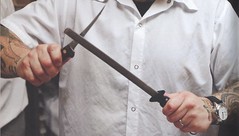 fig. a: this guy means business
fig. a: this guy means business
Nate Appleman has since moved on to the bright lights of the big city and a starring role at Pulino's, the Bowery bar & pizzeria that is restaurateur Keith McNally's latest joint, but the A16 cookbook (A16: Food + Wine), which documents Appleman's days in San Francisco and his partnership with Shelley Lindgren, remains one of our faves of the last couple of years.
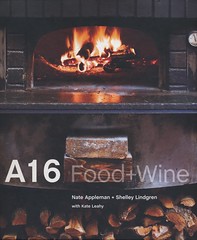 fig. b: A16, the book
fig. b: A16, the book
And one of the things that we admire the most about the A16 cookbook, and about Appleman's technique, is his insistence on the pickling and preserving of the freshest ingredients at the height of season in order to develop a veritable arsenal of flavors at one's disposal. Appleman's hardly the only one to cultivate this approach--this is obviously a highly traditional approach to cuisine--but not everyone is as committed to this culinary philosophy as Appleman is, not everyone has his flair when it comes to combining flavors, and not everyone's got his tattoos. There's a reason Appleman was the recipient of a James Beard Foundation Rising Star award last year.
Anyway, leafing through A16: Food + Wine can be a little bit frustrating at times, precisely because of this insistence on preserving. The book is full of tantalizing recipes that require you to have built up your pantry first. But build up your pantry even just a little, and all of a sudden the world according to Nate begins to open up for you, and the beauty and simplicity of so many of his recipes will have you diving right in.
Take Appleman's recipe for Preserved Meyer Lemons. The recipe looks like this:
Preserved Meyer Lemons
8 Meyer lemons
a generous amount of kosher salt
freshly squeezed Meyer lemon juice, as needed
Wash the lemons well and dry them with a towel. Working from the blossom end of the lemon, quarter each of them with a paring knife, stopping just before you cut through the stem end. Each lemon will look like 4 separate wedges held together by the intact stem end.
Working from the blossom end, pack the inside of each lemon with about two heaping tablespoons of salt. Place the lemons in a large canning jar in which they fit snugly, and cover with a generous layer of salt. Cover the jar tightly and leave it out at room temperature for a couple of days, or until the lemons submerge themselves in their own juice. If the lemons do not release enough juice, add freshly squeezed lemon juice to cover. Refrigerate the jar for at least three weeks before using, checking in on the lemons every now and then to make sure they're still submerged in their juice. The lemons will keep indefinitely if they are completely covered with juice.
To use a preserved lemon, slice off the still-attached stem end to separate the wedges. Using a sharp paring knife, remove the flesh and the pith from the rind and discard them. Soak the rind in cold water for 30 minutes to leach out the excess salt, and then mince the amount of rind called for by the recipe. Any leftover cleaned rind can be kept, submerged in water, for up to one week in the refrigerator.
Clearly, you're going to have to plan ahead on this one (unless you happen to have a source for preserved lemons in your hometown), but once you've made them, not only do you have a seriously phenomenal ingredient on-hand, one that you could use for all kinds of North African, Spanish, and Italian preparations, but you also have a key ingredient allowing you to make such A16 knockouts as Braised Halibut with Pistachios, Preserved Meyer Lemon, and Capers.
A jar of Preserved Meyer Lemons is like a beam of sunshine radiating out of your refrigerator every time you open it, but don't get hung up on getting Meyer lemons if you live somewhere where they're unavailable or overly cost-prohibitive, or if you missed the season--just find yourself the best, most fragrant, wax-free, and possibly organic lemons you can afford. You won't regret it. And, again, if you happen to live somewhere where you can buy preserved lemons at your local Moroccan, North African, or Middle Eastern specialty foods store, feel free to cut corners.
But let's say you've got the time and the patience. When you've aged a jar of those beautiful preserved lemons to perfection, you can go ahead and make this dish:
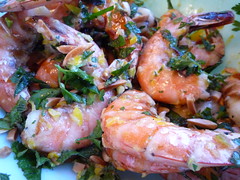 fig. c: shrimp by A16
fig. c: shrimp by A16Grilled Shrimp with Pickled Peppers, Preserved Meyer Lemon, and Toasted Almonds.
Looks and sounds tasty, right?
Now, the thing is, in order to do so, you'll need one more batch of preserves--Appleman's Pickled Peppers--but fret not, these only take an hour or two to make. And while the original A16 recipe calls for Gypsy Peppers, a sweet pepper that's in the same general category as Italian fryers, certain Hungarian peppers, and sweet banana peppers, use whatever flavorful mild to medium-hot pepper you have available where you live. You can even go with a little heat, if you like--the peppers become a little milder after they've been pickled, and the recipe calls for the addition of some jalapeños anyway.
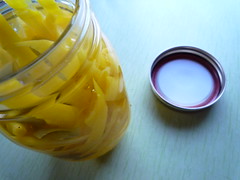 fig. d: peppers, pickled
fig. d: peppers, pickledPickled Peppers
1 pound Gypsy peppers
2 red jalapeño peppers
2 cloves garlic, smashed with the side of a knife and peeled
2 teaspoons kosher salt
2 cups distilled white vinegar
1 1/2 cups water
Halve the peppers and chiles and remove the stems, seeds, and membranes. Cut the peppers lengthwishe into 1/2- to 1-inch-wide strips. Coarsely chop the jalapeños. In a heatproof bowl, combine the peppers, the jalapeños, the garlic, and the salt.
In a pot, combine the vinegar and water and bring them to a boil. Remove from the heat and pour over the pepper mixture.
fig. e: peppers, pickling
Let stand for about 1 hour, or until cool. Using a slotted spoon, transfer the peppers to a jar or other container in which they fit snugly. Pour in the pickling liquid, making sure the peppers are fully submerged. Cover tightly and store in the refrigerator for up to 3 weeks.
Okay. You've got your preserved lemons, you've got your pickled peppers. Now you're ready to make the shrimp.
Grilled Shrimp with Pickled Peppers, Preserved Meyer Lemon, and Toasted Almonds
1 1/2 pounds fresh or thawed shrimp in the shell, like Matane shrimp, preferably with theirs heads on (roughly 24-30 shrimp)
kosher salt
1 1/2 cups pickled peppers (see recipe above), coarsely chopped
1 tablespoon soaked and chopped preserved Meyer lemon (see recipe and directions above)
1/2 cup extra virgin olive oil
2 tbp freshly squeezed lemon juice
2/3 cup whole almonds, toasted*
1 tbsp chopped flat-leaf parsley
1 tbsp chopped fresh mint
Toss the shrimp in a bowl with a couple generous pinches of salt. Cover and refrigerate for at least 1 hour and up to 4 hours.
In a food processor, combine the pickled peppers and chiles and the preserved lemon and process until almost smooth. Transfer the mixture to a bowl and stir in the olive oil and lemon juice. Taste for seasoning and add salt or a splash of the pickling liquid if needed. Set aside.
Prepare a hot fire in a grill, spreading the coals evenly for direct-heat cooking.
To prepare the shrimp, peel away the middle section of the shell, leaving the head and tail segments intact, and trim off any long antennae. Make a shallow slit along the back, and lift out and discard the dark, vein-like intestinal tract, if you so desire.
When the fire is ready, arrange the shrimp on the rack and grill, turning them over once, for no more than 4 minutes total, or until opaque. Be careful not to overcook the shrimp, or they will become tough.
Arrange the shrimp on a platter and drizzle generously with the pepper sauce. Sprinkle the almonds over top, garnish with the parsley and mint, and serve immediately.
Eat with your hands and enjoy. These shrimp make for a delicious mess.
[adapted slightly from A16: Food + Wine]
Now, Appelman's grilled shrimp are outstanding--that combination of the preserved lemon & pickled pepper sauce, the toasted almonds, the mint, and the smokiness of the shrimp is truly out of this world--and they're fantastic as an appetizer or a side dish, but the recipe can also be easily adapted into something a little more substantial.
For instance, it makes a great pasta dish if you peel the shrimp before tossing them with the sauce, the almonds, the herbs, a pound of freshly cooked, al dente capellini, and just a little of the pasta water from your pot.
You can also use this sauce with other types of seafood because, let's face it, Montreal's not the greatest shrimp city. With the exception of the painfully short Matane shrimp season, our shrimp are far from local or even regional, and the devastating impact of the BP oil disaster is likely to make things exponentially worse. Montreal is a great lobster city, however, and we're right in the thick of Quebec's late-spring/early-summer lobster season, so why not make the recipe with steamed or (even better) grilled lobster instead? Start with a live lobster, and you can't get any fresher. Serve the finished product over Bibb lettuce, and you'll have yourself an exceptionally great seafood salad.
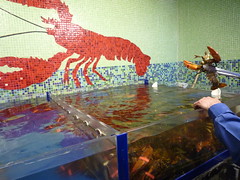 fig. f: shadowplay
fig. f: shadowplayThat's exactly what we did.
Not sure if Mr. Appleman would approve, but it sure tasted sensational to us.
aj
* To toast nuts, preheat your oven to 300º F. Spread the nuts in a single layer on a rimmed baking sheet and toast, tossing, and rotating the pan often, for 10-20 minutes, depending on the nut and whether or not the skins are on them. Skinned nuts take less time. Skinned and slivered or chopped nuts take even less (maybe as little as 5-7 minutes). Toast until the nuts are aromatic and golden. With skin-on nuts such as almonds, test for doneness by breaking a nut in half. It should have a consistently light caramel color at the center. Be very careful not to burn them, or you'll have to start over, because the flavors will be thrown off.








No comments:
Post a Comment